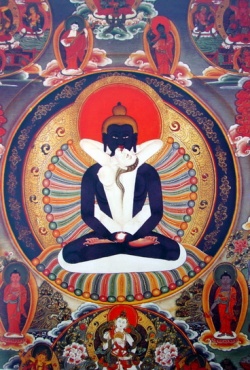Ādi-Buddha
Ādi-Buddha (devanāgarī: आदि बुद्ध) is a compound Sanskrit term from ādi ("first") and buddha, meaning the "Primordial Buddha." In Vajrayana Buddhism the term refers to a self-emanating, self-originating Buddha, present
before anything else existed. Although not a creator, it is the originator of all things. In Theosophical literature it is frequently used as a synonym of the Absolute Reality.
In Vajrayana Buddhism
Adi-Buddha can be regarded as a deity in an emanationist sense. Though all Buddhist figures are said to be emanations of the Adi-Buddha, certain famous Bodhisattvas are revered as its actual personality (often referred to as Dharmakāya, or "body of reality"). For example, in the Nyingma school, Adibuddha is Samantabhadra, the Spirit of
Truth; in the Gelug and Kagyu schools, Vajradhara (Tib. Dorje Chang) is regarded as Adi-Buddha; while in Shingon Buddhism it is Vairocana (Jap. Dainchi Nyorai).
Blavatsky's view
Mme. Blavatsky followed the tradition of the Gelug school identifying Adi-Buddha with Vajradhara:
Ādi-Buddha is Vajradhara, and the Dhyāni-Buddhas are Vajrasattva; yet though these two are different Beings on their respective planes, they are identical in fact, one acting through the other, as a Dhyāni through a human Buddha)".
However, in another passage, Vajradhara is not equated to Adi-Buddha, but rather seen as the First Logos radiating from the Absolute:
In the esoteric, and even exoteric Buddhism of the North, Adi Buddha (Chogi dangpoi sangye), the One unknown, without beginning or end, identical with Parabrahm and Ain-Soph, emits a bright ray from its darkness.
This is the Logos (the first), or Vajradhara, the Supreme Buddha (also called Dorjechang).
In Theosophy
The Theosophical literature regards Adi-Buddha as Parabrahman or sometimes as an aspect of it, related to the Absolute Wisdom. For example, H. P. Blavatsky says that Ādi-Buddha is "the Wisdom-Principle, which is Absolute, and
therefore out of space and time". Although this interpretation may sound unorthodox from the Buddhist point of view, she says in a footnote that this is an esoteric interpretation "taken from the secret portions of Dus-Kyi Khorlo
(Kâla-Chakra, in Sanskrit, or the “Wheel of Time,” or duration)". In other writings she also defines Adi-Buddha as "Primordial Universal Wisdom" and a symbol of "the universal and abstract principle of divine wisdom."
Ādi-Buddhi
Mme. Blavatsky mentions "the Boundless Âdi-Buddhi (primeval and Universal Soul)" as a term related to Âdi-Buddha or Wisdom. In The Mahatma Letters Ādi-Buddhi is identified with Yin Sin, "the one form of existence", and also with Dharmakāya, "the mystic, universally diffused essence". Ādi-Buddhi is also defined as: "the aggregate
intelligence of the universal intelligences including that of the Dhyan Chohans even of the highest order" and "the all-pervading supreme and absolute intelligence with its periodically manifesting Divinity — Avalokiteshvara".
The connection with Avalokiteshvara is also mentioned by Mme. Blavatsky, who wrote that "Parabrahman or Adi-Buddha is eternally manifesting itself as Jivatma (7th principle) or Avalokiteswara".
